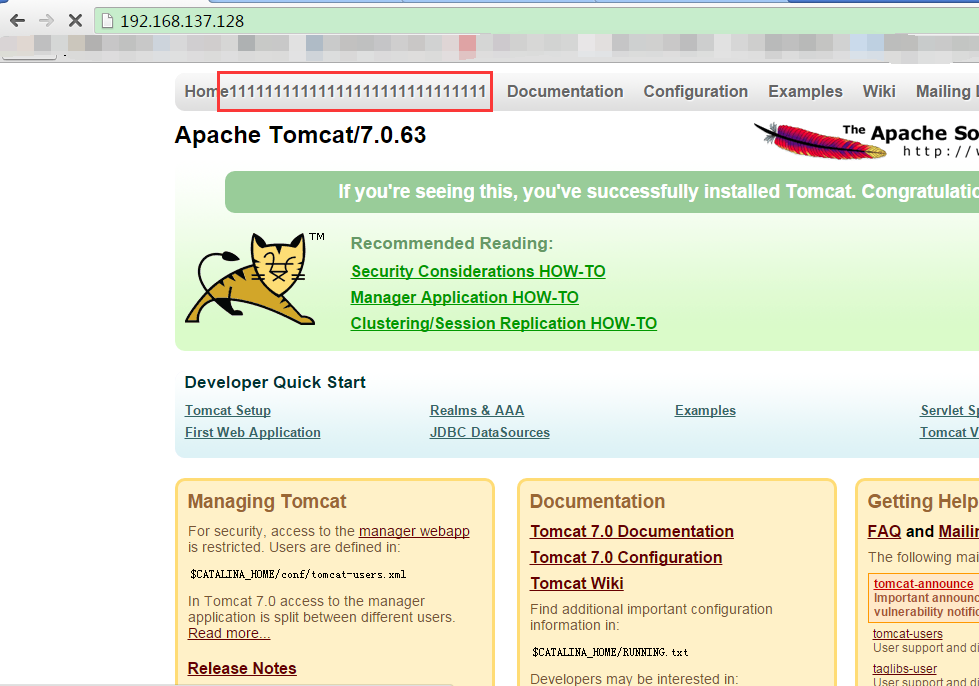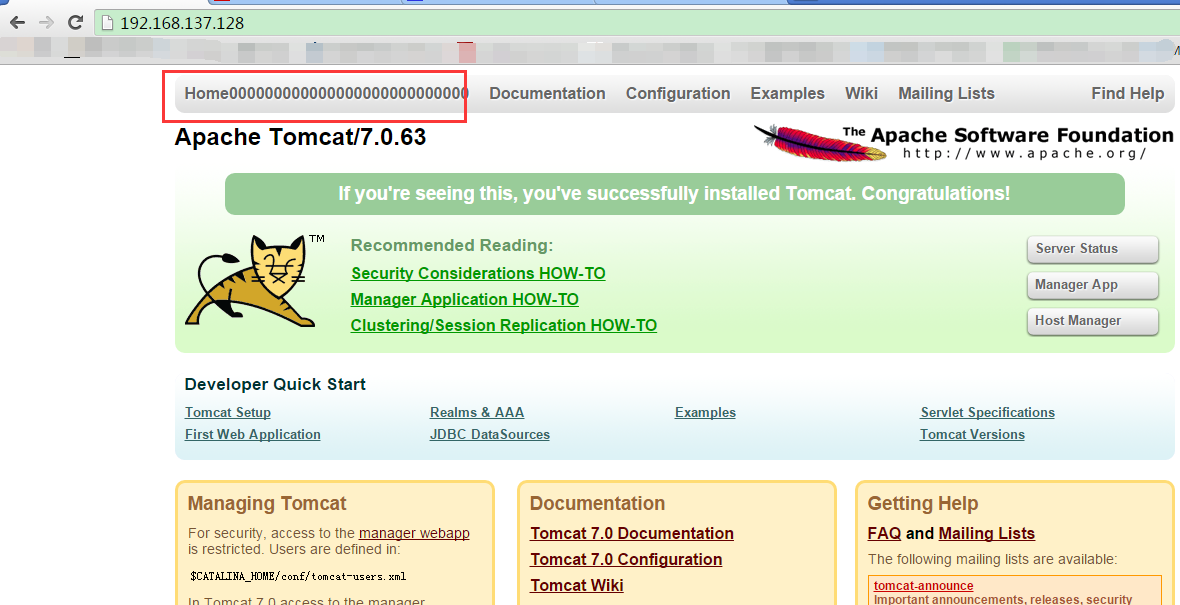3台Centos
192.168.137.128 (Nginx)
192.168.137.129(Tomcat 端口8080)
192.168.137.131(Tomcat 端口8080)
(如果复制的VM的网卡不可用 可删除/etc/udev/rules.d/70-persistent-net.rules 文件 我的是70开头,有的不一样 可以执行 echo null >> 70-persistent-net.rulesj 空了 然后reboot 就可以看到网卡了)
配置免登陆
ssh-keygen -t ras 一路回车 会在/root/.ssh/生成公钥和私钥
接下来推送(128机器)
cat id_rsa.pub | ssh root@192.168.137.129 /root/.ssh/authorized_keys
在登陆129 给这个文件755权限
chmod 755 authorized_keys
然后回到128机器
ssh 192.168.137.129
ok
开放端口8080 这里有开放端口,不关闭防火墙
安装nginx(1.9.9)
wget http://nginx.org/download/nginx-1.9.9.tar.gz
解压
tar -zxvf nginx-1.9.9.tar.gz
进入目录
设置路径
./configure –prefix=/usr/local/nginx
编译
make
安装
make install
ok了 启动
cd /usr/local/nginx/sbin
./nginx
就可以访问了 出现wellcome Nginx 就可以了
上传tomcat 到139,131机器
scp 文件 root@192.168.137.129:/root
scp 文件 root@192.168.137.131:/root
两个机器解压
tar -zxvf apache-tomcat-7.0.63.tar.gz /usr/local/tomcat/
配置nginx.conf
vim /usr/local/nginx/conf/nginx.conf
#user nobody;
worker_processes 1;
#error_log logs/error.log;
#error_log logs/error.log notice;
#error_log logs/error.log info;
#pid logs/nginx.pid;
events {
worker_connections 1024;
}
http {
include mime.types;
default_type application/octet-stream;
#log_format main '$remote_addr - $remote_user [$time_local] "$request" '
# '$status $body_bytes_sent "$http_referer" '
# '"$http_user_agent" "$http_x_forwarded_for"';
#access_log logs/access.log main;
sendfile on;
#tcp_nopush on;
#keepalive_timeout 0;
keepalive_timeout 65;
#gzip on;
#配置被代理服务器2个
upstream backend {
server 192.168.137.129:8080;
server 192.168.137.131:8080;
}
server {
listen 80;
server_name localhost;
#charset koi8-r;
#access_log logs/host.access.log main;
location / {
#这里的backend 和要上面的upstream 后的名称一样
proxy_pass http://backend;
}
#error_page 404 /404.html;
# redirect server error pages to the static page /50x.html
#
error_page 500 502 503 504 /50x.html;
location = /50x.html {
root html;
}
# proxy the PHP scripts to Apache listening on 127.0.0.1:80
#
#location ~ \.php$ {
# proxy_pass http://127.0.0.1;
#}
# pass the PHP scripts to FastCGI server listening on 127.0.0.1:9000
#
#location ~ \.php$ {
# root html;
# fastcgi_pass 127.0.0.1:9000;
# fastcgi_index index.php;
# fastcgi_param SCRIPT_FILENAME /scripts$fastcgi_script_name;
# include fastcgi_params;
#}
# deny access to .htaccess files, if Apache's document root
# concurs with nginx's one
#
#location ~ /\.ht {
# deny all;
#}
}
# another virtual host using mix of IP-, name-, and port-based configuration
#
#server {
# listen 8000;
# listen somename:8080;
# server_name somename alias another.alias;
# location / {
# root html;
# index index.html index.htm;
# }
#}
# HTTPS server
#
#server {
# listen 443 ssl;
# server_name localhost;
# ssl_certificate cert.pem;
# ssl_certificate_key cert.key;
# ssl_session_cache shared:SSL:1m;
# ssl_session_timeout 5m;
# ssl_ciphers HIGH:!aNULL:!MD5;
# ssl_prefer_server_ciphers on;
# location / {
# root html;
# index index.html index.htm;
# }
#}
}
修改上面的注释的两个地方就可以了
保存!
wq
开启129,131的tomcat
(可以在两个tomcat的webapp/ROOT/index.jsp做点手脚 好区分 我就改了一个HOME加个11111111111另一个0000000000000)
好了我们重启nginx
./nginx -s reload
不报错就说明OK了


两次我们访问的是nginx ,但是访问的是129和131机器的tomcat,做到了负载均衡,我们可以对nginx搭建集群,这里分配的是hash分配算法.比较简单.
作为 service启动:
vi /etc/init.d/nginx
吧下面的复制过去路径不一样的需要改路径
#!/bin/bash
# nginx Startup script for the Nginx HTTP Server
# it is v.0.0.2 version.
# chkconfig: - 85 15
# description: Nginx is a high-performance web and proxy server.
# It has a lot of features, but it's not for everyone.
# processname: nginx
# pidfile: /var/run/nginx.pid
# config: /usr/local/nginx/conf/nginx.conf
nginxd=/usr/local/nginx/sbin/nginx
nginx_config=/usr/local/nginx/conf/nginx.conf
nginx_pid=/var/run/nginx.pid
RETVAL=0
prog="nginx"
# Source function library.
. /etc/rc.d/init.d/functions
# Source networking configuration.
. /etc/sysconfig/network
# Check that networking is up.
[ ${NETWORKING} = "no" ] && exit 0
[ -x $nginxd ] || exit 0
# Start nginx daemons functions.
start() {
if [ -e $nginx_pid ];then
echo "nginx already running...."
exit 1
fi
echo -n $"Starting $prog: "
daemon $nginxd -c ${nginx_config}
RETVAL=$?
echo
[ $RETVAL = 0 ] && touch /var/lock/subsys/nginx
return $RETVAL
}
# Stop nginx daemons functions.
stop() {
echo -n $"Stopping $prog: "
killproc $nginxd
RETVAL=$?
echo
[ $RETVAL = 0 ] && rm -f /var/lock/subsys/nginx /var/run/nginx.pid
}
# reload nginx service functions.
reload() {
echo -n $"Reloading $prog: "
#kill -HUP `cat ${nginx_pid}`
killproc $nginxd -HUP
RETVAL=$?
echo
}
# See how we were called.
case "$1" in
start)
start
;;
stop)
stop
;;
reload)
reload
;;
restart)
stop
start
;;
status)
status $prog
RETVAL=$?
;;
*)
echo $"Usage: $prog {start|stop|restart|reload|status|help}"
exit 1
esac
保存 给权限
chmod a+x /etc/init.d/nginx
测试
[root@localhost sbin]# service nginx start
正在启动 nginx: [确定]
ok了
























 941
941

 被折叠的 条评论
为什么被折叠?
被折叠的 条评论
为什么被折叠?








